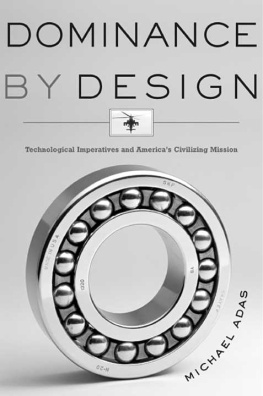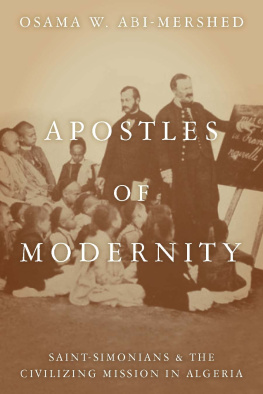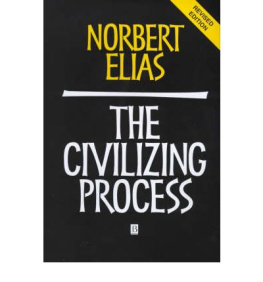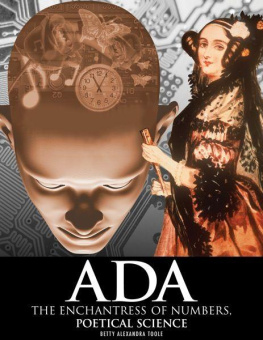Michael Adas - Dominance by Design: Technological Imperatives and Americas Civilizing Mission
Here you can read online Michael Adas - Dominance by Design: Technological Imperatives and Americas Civilizing Mission full text of the book (entire story) in english for free. Download pdf and epub, get meaning, cover and reviews about this ebook. year: 2009, genre: Politics. Description of the work, (preface) as well as reviews are available. Best literature library LitArk.com created for fans of good reading and offers a wide selection of genres:
Romance novel
Science fiction
Adventure
Detective
Science
History
Home and family
Prose
Art
Politics
Computer
Non-fiction
Religion
Business
Children
Humor
Choose a favorite category and find really read worthwhile books. Enjoy immersion in the world of imagination, feel the emotions of the characters or learn something new for yourself, make an fascinating discovery.
- Book:Dominance by Design: Technological Imperatives and Americas Civilizing Mission
- Author:
- Genre:
- Year:2009
- Rating:3 / 5
- Favourites:Add to favourites
- Your mark:
- 60
- 1
- 2
- 3
- 4
- 5
Dominance by Design: Technological Imperatives and Americas Civilizing Mission: summary, description and annotation
We offer to read an annotation, description, summary or preface (depends on what the author of the book "Dominance by Design: Technological Imperatives and Americas Civilizing Mission" wrote himself). If you haven't found the necessary information about the book — write in the comments, we will try to find it.
Michael Adas: author's other books
Who wrote Dominance by Design: Technological Imperatives and Americas Civilizing Mission? Find out the surname, the name of the author of the book and a list of all author's works by series.
Dominance by Design: Technological Imperatives and Americas Civilizing Mission — read online for free the complete book (whole text) full work
Below is the text of the book, divided by pages. System saving the place of the last page read, allows you to conveniently read the book "Dominance by Design: Technological Imperatives and Americas Civilizing Mission" online for free, without having to search again every time where you left off. Put a bookmark, and you can go to the page where you finished reading at any time.
Font size:
Interval:
Bookmark:



MICHAEL ADAS
For my grandfather, Lawrence B. Rivard engineer and inventor and my grandson, Malcolm Shaw Wilson who always wants to know the Purpose of things


[To view this image, refer to the print version of this title.]
A woodblock impression by Hiroshige, one of Japan's most popular nineteenthcentury artists, of the black-hulled steamships and miniature train that were the centerpieces of Admiral Matthew Perry's expedition to Japan in 1843-i844. Library of Congress.
[To view this image, refer to the print version of this title.]
The Japanese are remarkable for their inordinate curiosity and, in the display of so many of the inventions of our ingenious countrymen, they had ample means of gratifying this propensity.
-MATTHEW C. PERRY, 1854

 ommoclore Matthew Calbraith Perry had overseen the preparations for the naval expedition with an attention to detail that would be well appreciated by his reluctant Japanese hosts. He had read the fifty or sixty books that were available on the little-known islands and reclusive people that many influential Americans had become convinced must be drawn-preferably by persuasion, by force if necessary-into the rapidly expanding global system. While his agents gathered reading material in the
ommoclore Matthew Calbraith Perry had overseen the preparations for the naval expedition with an attention to detail that would be well appreciated by his reluctant Japanese hosts. He had read the fifty or sixty books that were available on the little-known islands and reclusive people that many influential Americans had become convinced must be drawn-preferably by persuasion, by force if necessary-into the rapidly expanding global system. While his agents gathered reading material in the
The Japanese are remarkable for their inordinate curiosity and, in the display of so many of the inventions of our ingenious countrymen, they had ample means of gratifying this propensity. bookstores of New York and London in the early 1850s, Perry interviewed merchants and studied reports by American and European sea captains who had preceded him on missions to the islands. Incensed by the curt rebuffs and humiliations these earlier envoys had endured, Perry was determined to put together an embassy so imposing that the Japanese ruler would not dare refuse the summons he carried in a letter from the president of the United States, Millard Fillmore, which exhorted the shogun to act vigorously to open his kingdom to international commercial exchange and political intercourse.
An accomplished diplomat, who had successfully negotiated with leaders from states as diverse as Naples, Liberia, and Mexico, Perry was an obvious choice to head the expedition to Japan. He decided long before he set out from Norfolk, Virginia, in late November 1852, to present himself as a somewhat inscrutable but decidedly dignified plenipotentiary who would tolerate no slights to his country and would persevere until its demands were met. His diplomatic experience and his personal inquiries had convinced him that he must sail into the Uraga Channel that led to the Japanese capital at Edo with a powerful fleet of vvarships that included the most modern steam frigates. Though the sizeable flotilla Perry had been promised had been reduced to four (only two of which were steam-driven) by the time the expedition reached Japan on July 8, 1853, he choreographed a military display for his first venture ashore to meet with the emissaries of the shogun, Tokugawa Ieyoshi. On the morning of July 14, more than a hundred well armed U.S. marines marched up the wharf near the village of Kurihama and snapped to attention in two long lines along the path to a hastily constructed reception hall where Japanese dignitaries awaited the landing party. A hundred sailors and two bands playing "Hail, Columbia!" led Perry and his fellow officers between the smartly attired columns to present President Fillmore's letter to the warrior-aristocrats representing the "emperor" of Japan. The letter and Perry's credentials were inscribed in vellum bound in blue velvet, and the seal for each document was encased in a box of fine gold. The documents were carried ahead of the commodore by two boys, and he was flanked on each side by tall, muscular "Negro" guards, with two sailors of "stalwart proportions" following behind.'
Perry's admission in his official account of the expedition that the splendid procession "was but for effect" suggests that he may have been quite aware of the special resonance his grand show would have for the Japanese officials, who were drawn from an elite samurai culture that revered elaborate and well-performed rituals. Samuel Wells Williams, an American missionary serving in China who joined the expedition as an interpreter, had the distinct impression that "the Japanese were sorry to see the shoe- end so soon."' Perry had carefully calibrated the impressions he intended to evoke through successive revelations of technological wonders. These marvels would be dramatically displayed by both the mighty ships that transported the embassy and the presents that had been meticulously chosen for the shogun and his emissaries, many of whom were powerful dainryos or lords of the patchwork of feudal fiefdoms (han) that made up the Tokugawa realm. Perry's tireless efforts to persuade often skeptical congressmen and Washington bureaucrats to provide him with an impressive fleet of the most advanced ships were driven by his conviction that a clear demonstration of U.S. naval superiority was essential if significant concessions were to be extracted from the Japanese. To this end, he seized every opportunity to invite Tokugawa notables to tour his frigates and to examine the steam engines below decks and the formidable Paixhans cannon above.'
Despite these successes, Perry was discomfited by the fact that he had been compelled, by reports of attempted landings by Russian rivals, to hurry to Japan with fewer than half the ships that had been assigned to the expedition. That concern may in part explain his abrupt departure from the islands soon after the ceremonies at Kurihama. Fearful that the limited supplies his truncated fleet carried would leave him dependent on the Japanese for vital provisions, Perry gave orders to sail out of the Uraga Channel on the morning of July 17, after informing the Japanese commissioners that he would return within months to receive the shogun's reply to the president's letter. The expedition then made its way back to China, where Perry planned to rendezvous with the ships that had not arrived in time for the initial voyage.
Font size:
Interval:
Bookmark:
Similar books «Dominance by Design: Technological Imperatives and Americas Civilizing Mission»
Look at similar books to Dominance by Design: Technological Imperatives and Americas Civilizing Mission. We have selected literature similar in name and meaning in the hope of providing readers with more options to find new, interesting, not yet read works.
Discussion, reviews of the book Dominance by Design: Technological Imperatives and Americas Civilizing Mission and just readers' own opinions. Leave your comments, write what you think about the work, its meaning or the main characters. Specify what exactly you liked and what you didn't like, and why you think so.










